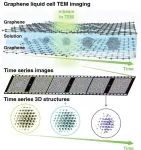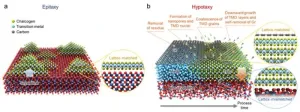(Press-News.org) March 4, 2025 — For patients undergoing nerve transfer surgery for facial palsy, Botox injections can improve facial symmetry by reducing overactivity of the muscles on the unaffected side, suggests a study in the March issue of Plastic and Reconstructive Surgery®, the official medical journal of the American Society of Plastic Surgeons (ASPS). The journal is published in the Lippincott portfolio by Wolters Kluwer.
The added benefit of Botox reflects modifications in brain functional network connectivity, according to the new research, led by Ye-Chen Lu, MD, PhD, and Wei Wang, MD, PhD, of Shanghai Jiao Tong University School of Medicine, China. They write, "These findings imply that enhanced connectivity between brain functional networks play a vital role in the recovery process from neurological disorders."
BoNT-A improves outcomes of surgery for facial palsy
Facial nerve injury can cause paralysis on the affected side of the face, leading to functional and cosmetic impairments. For patients with this condition, nerve transfer surgery is recommended to restore facial nerve function and symmetry.
However, many patients have persistent impairment after surgery, especially drooping of the corner of the mouth (oral commissure) on the affected side. This condition has been linked to overactivity of the muscles on the opposite side, leading to facial asymmetry even at rest.
Such patients have been successfully treated using botulinum toxin-A (BoNT-A; best known by the brand name Botox) to produce temporary relaxation of overactive muscles on the unaffected side. Previous studies suggest lasting improvement, even after the effects of BoNT-A fade.
Benefits linked to changes in brain network connectivity
"We hypothesize that BoNT-A treatment triggers extensive cortical plasticity, offering a potential explanation for its long-lasting therapeutic impact on patients with facial asymmetry," the researchers write. They used functional magnetic resonance imaging (fMRI) scans to assess functional activity of brain networks before and after surgery and BoNT-A treatment.
The study included 38 patients with facial palsy and "severe oral commissure drooping" after surgery for benign tumors (acoustic neuromas). All underwent nerve transfer surgery followed by facial training and rehabilitation. In addition, patients were randomly assigned to a treatment group receiving a series of BoNT-A injections of the facial muscles on the unaffected side; or a control group receiving no BoNT-A.
Patients receiving BoNT-A had significant improvement in facial asymmetry. "BoNT-A injections improved facial static function without affecting smile function," the researchers write. As in previous studies, the benefits persisted beyond six months, after the effects of BoNT-A wore off.
Before surgery and one year later, patients underwent fMRI scans to assess changes in in brain functional network connectivity. Of nine resting state networks (RSNs) studied, five showed "significant differences of spatial distribution" between groups. Patients receiving BoNT-A "displayed an overall stronger interaction between several RSNs" – notably including the sensorimotor and visual networks.
"Our research provides evidence of long-term and widespread changes in cerebral networks among facial paralysis patients," Drs Lu and Wang and coauthors write. These effects may explain why the improvement persists even after the effects of BoNT-A dissipate.
BoNT-A injections "may create a "window of time for nerve reanimation, allowing the brain to learn and restore proper facial muscle activity." The researchers conclude: "These findings imply that enhanced connectivity between brain functional networks play a vital role in the recovery process from neurological disorders."
Read Article: Facial Symmetry Enhancement and Brain Network Modifications in Facial Palsy Patients after Botulinum Toxin Type A Treatment
Wolters Kluwer provides trusted clinical technology and evidence-based solutions that engage clinicians, patients, researchers and students in effective decision-making and outcomes across healthcare. We support clinical effectiveness, learning and research, clinical surveillance and compliance, as well as data solutions. For more information about our solutions, visit https://www.wolterskluwer.com/en/health.
###
About Wolters Kluwer
Wolters Kluwer (EURONEXT: WKL) is a global leader in information, software solutions and services for professionals in healthcare; tax and accounting; financial and corporate compliance; legal and regulatory; corporate performance and ESG. We help our customers make critical decisions every day by providing expert solutions that combine deep domain knowledge with technology and services.
Wolters Kluwer reported 2023 annual revenues of €5.6 billion. The group serves customers in over 180 countries, maintains operations in over 40 countries, and employs approximately 21,400 people worldwide. The company is headquartered in Alphen aan den Rijn, the Netherlands.
For more information, visit www.wolterskluwer.com, follow us on LinkedIn, Facebook, YouTube and Instagram.
END
Brain functional networks adapt in response to surgery and Botox for facial palsy
Study in Plastic and Reconstructive Surgery documents cerebral plasticity after nerve transfer surgery
2025-03-04
ELSE PRESS RELEASES FROM THIS DATE:
Multimodal AI tool supports ecological applications
2025-03-04
By Shawn Ballard
Ever seen an image of an animal and wondered, “What is that?” TaxaBind, a new tool developed by computer scientists in the McKelvey School of Engineering at Washington University in St. Louis, can sate that curiosity and more.
TaxaBind addresses the need for more robust and unified approaches to ecological problems by combining multiple models to perform species classification (what kind of bear is this?), distribution mapping (where are the cardinals?), and other tasks related to ecology. The tool can also be used as a starting point for larger studies related to ecological modeling, which scientists might use to predict shifts in plant and animal populations, ...
New University of Minnesota research shows impact of anxiety and apathy on decision-making
2025-03-04
MINNEAPOLIS/ST. PAUL (3/04/2025) — Making decisions in uncertain situations is part of daily life. New research from the University of Minnesota Medical School has uncovered that anxiety and apathy — two common but distinct emotional states — lead to fundamentally different patterns in how people learn and make decisions.
The findings were recently published in Biological Psychiatry: Cognitive Neuroscience and Neuroimaging.
The study investigated how anxiety and apathy — or a lack of interest and ...
Fred Hutch announces 10 recipients of the 2025 Harold M. Weintraub Graduate Student Award
2025-03-04
Fred Hutch Cancer Center announced 10 recipients of the annual Harold M. Weintraub Graduate Student Award, which recognizes the exceptional achievements of graduate studies in the biological sciences.
This year’s recipients represent both national and international research institutions, with a variety of thesis topics including the structural organization of neural networks, a hereditary basis for metastatic breast cancer, gene editing tools for neurodegenerative diseases and the brain’s ability to control the tongue.
“We congratulate the impressive group of domestic and international applicants this year ...
30 million euros for a novel method of monitoring the world's oceans and coastal regions using telecommunications cables
2025-03-04
Summary
The worldwide network of telecommunications cables lying on the bottom of the world's oceans offers unique potential for scientific use if the fibre-optic cables themselves are used as or equipped with sensors. Based on this, the GFZ Helmholtz Centre for Geosciences in Potsdam and the GEOMAR Helmholtz Centre for Ocean Research Kiel are now setting up the research infrastructure SAFAtor (SMART Cables And Fiber-optic Sensing Amphibious Demonstrator), that can be used to monitor the world's oceans. It will be included in the portfolio of the major Helmholtz infrastructures and funded by ...
New multicenter study shows: Which treatment helps best with high-risk acute pulmonary embolism
2025-03-04
A current study involving the University Hospital Bonn (UKB) has investigated which treatment strategy offers the best chances of survival in high-risk acute pulmonary embolism. The results, now published in the renowned journal "Intensive Care Medicine", provide crucial information for the future treatment of this life-threatening disease.
High-risk acute pulmonary embolism affects around five percent of all pulmonary embolisms and can take a dramatic course even in young people. Acute obstruction of the pulmonary circulation by a blood clot can lead to circulatory failure with a high mortality rate. The study, which was carried out in collaboration with 34 European centers ...
Hidden dangers and myths: What you need to know about HPV and cancer
2025-03-04
COLUMBUS, Ohio – While the human papillomavirus (HPV) is most associated with cervical cancer risk and women, a new survey commissioned by The Ohio State University Comprehensive Cancer Center – Arthur G. James Cancer Hospital and Richard J. Solove Research Institute (OSUCCC – James) shows that the majority of people are unaware that the virus is actually more common among men than women and is associated with rising rates of other cancers that directly impact men.
The consumer survey sought to understand the public’s knowledge of the lesser known but common virus – specifically how it is spread and its impact on cancer risk.
Survey ...
SNU researchers develop world’s first technology to observe atomic structural changes of nanoparticles in 3D
2025-03-04
Seoul National University College of Engineering announced that Professor Jungwon Park’s research team from the Department of Chemical and Biological Engineering has developed a groundbreaking technology to observe atomic structural changes of nanoparticles in three dimensions.
This study, recognized as a revolutionary achievement that resolves a long-standing challenge even past Nobel laureates could not solve, was published online in Nature Communications, one of the most prestigious international journals, on January 29.
Recently, nanoparticles have garnered significant attention as they are widely used in developing functional materials for cutting-edge industries ...
SNU researchers develop a new synthesis technology of single crystal 2D semiconductors, “Hypotaxy,” to enhance the commercialization of next-generation 2D semiconductors
2025-03-04
College of Engineering at Seoul National University announced that a research team led by Professor Gwan-Hyoung Lee from the Department of Materials Science and Engineering, in collaboration with the research teams of Professors Hyejin Jang and Jeong Woo Han from the same department, has successfully developed the new synthesis technology of 2D semiconductors. This groundbreaking technique enables the direct growth of wafer-scale single-crystal 2D semiconductors on various substrates.
The research were published in "Nature," the world's most ...
Graphene production method offers green alternative to mining
2025-03-04
Researchers in Sweden report a green alternative to reduce reliance on mining graphite, the raw source behind the next wonder material, graphene.
In the latest volume of the scientific journal Small, researchers at KTH Royal Institute of Technology say they have developed a reproducible and scalable method for producing graphene oxide (GO) nanosheets from commercial carbon fibers, marking a breakthrough in sustainable nanomaterial synthesis.
The process involves exfoliating carbon fibers with nitric acid, which provides high yields of one-atom-thick sheets of graphene oxide with characteristics comparable ...
Researchers discover a cause of leptin resistance—and how to reverse it
2025-03-04
Worldwide obesity rates have more than doubled since 1990, with nearly a billion people now falling into the category. Though a complex interplay of genes, diet, and environment contribute, 90% of cases share one thing in common: leptin resistance.
In lean individuals, fat cells produce the hormone leptin, which suppresses appetite. But in most individuals with obesity, this signal fails to register. Why this happens has been a mystery for more than three decades, ever since Jeffrey M. Friedman’s laboratory at the Rockefeller University cloned the leptin gene in 1994.
But now Bowen Tan, Kristina Hedbacker, ...
LAST 30 PRESS RELEASES:
What causes some people’s gut microbes to produce high alcohol levels?
Global study reveals widespread burning of plastic for heating and cooking
MIT study shows pills that communicate from the stomach could improve medication adherence
Searching for the centromere: diversity in pathways key for cell division
Behind nature’s blueprints
Researchers search for why some people’s gut microbes produce high alcohol levels
Researchers find promising new way to boost the immune response to cancer
Coffee as a staining agent substitute in electron microscopy
Revealing the diversity of olfactory receptors in hagfish and its implications for early vertebrate evolution
Development of an ultrasonic sensor capable of cuffless, non-invasive blood pressure measurement
Longer treatment with medications for opioid use disorder is associated with greater probability of survival
Strategy over morality can help conservation campaigns reduce ivory demand, research shows
Rising temperatures reshape microbial carbon cycling during animal carcass decomposition in water
Achieving ultra-low-power explosive jumps via locust bio-hybrid muscle actuators
Plant-derived phenolic acids revive the power of tetracycline against drug-resistant bacteria
Cooperation: A costly affair in bacterial social behaviour?
Viruses in wastewater: Silent drivers of pollution removal and antibiotic resistance
Sub-iethal water disinfection may accelerate the spread of antibiotic resistance
Three in four new Australian moms struggle with body image
Post-stroke injection protects the brain in preclinical study
Cardiovascular risk score predicts multiple eye diseases
Health: estimated one in ten British adults used or interested in GLP-1 medications for weight loss
Exercise to treat depression yields similar results to therapy
Whooping cough vaccination for pregnant women strengthens babies’ immune system
Dramatic decline in new cases of orphanhood in Uganda driven by HIV treatment and prevention programs
Stopping weight loss drugs linked to weight regain and reversal of heart health markers
Higher intake of food preservatives linked to increased cancer risk
Mass General Brigham–developed cholera vaccine completes phase 1 trial
First experimental validation of a “150-year-old chemical common sense” direct visualization of the molecular structural changes in the ultrafast anthracene [4+4] photocycloaddition reaction
Lack of support for people on weight loss drugs leaves them vulnerable to nutritional deficiencies, say experts
[Press-News.org] Brain functional networks adapt in response to surgery and Botox for facial palsyStudy in Plastic and Reconstructive Surgery documents cerebral plasticity after nerve transfer surgery



